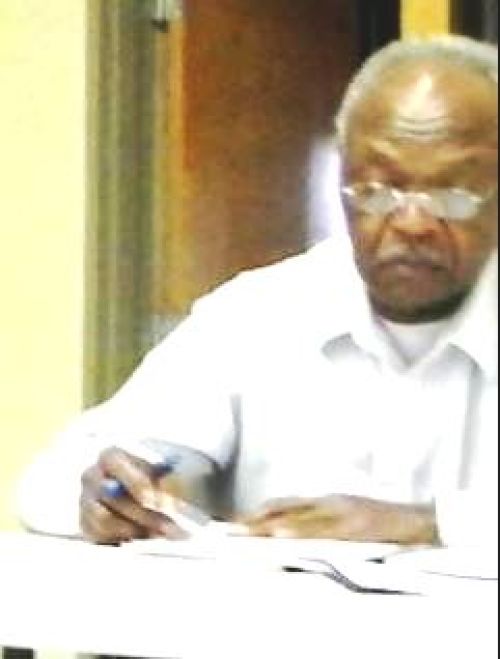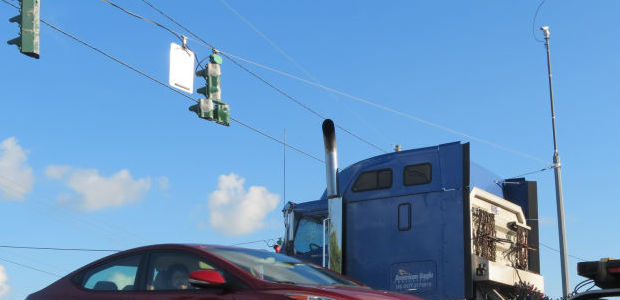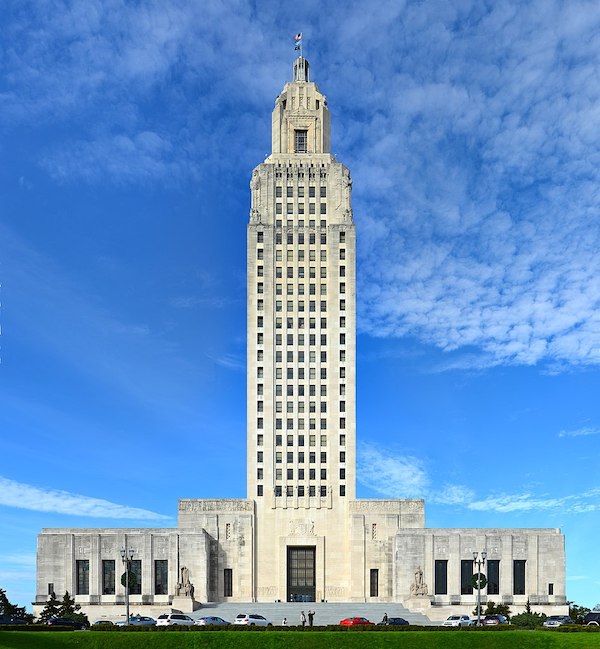
Doug’s aims to keep people cool this summer
June 18, 2013
HUD labels MCHA ‘troubled’ agency
June 18, 2013Hundreds of electronic eyes in residential neighborhoods, intelligence-gathering systems linking hometown police departments with state officials and the federal government, and discussions of public school children “paying” for lunch with their palm-prints.
Those are among manifestations of a nation where lines between personal privacy and public security increasingly blur.
The examples are not from big cities, but communities in the Tri-parish region and elsewhere in Louisiana.
Academics and civil liberties guardians – while recognizing the need for surveillance and intelligence-gathering – agree that most people have no idea Big Brother lurks within steps of the magnolia trees in their own front yards.
“I don’t think people are really aware of it,” said Dr. Kevin Fox Gotham, a sociology professor and Associate Dean of Academic Affairs at the Tulane University School of Liberal Arts. “There are so many ways to photograph and record visual imagery, I don’t think people know about the techniques and technology. People might not see it as problematic unless they are on the receiving end, perhaps because of a ticket they receive in the mail.”
Surveillance, intelligence programs and protocols maintained by local police departments have won praise for aiding criminal investigations, resulting in arrests of offenders ranging from murderers to purse-snatchers to copper thieves. The value of video surveillance was driven home earlier this year when it helped identify suspects in the deadly Boston Marathon bombing case.
But an audit of local practices reveals surprising information about the degree of video surveillance used and in the works, as well as fuzzy accountability for a powerful intelligence network operated by the Louisiana State Police in concert with federal authorities.
The State Police Fusion Center, on the agency’s Baton Rouge campus, is one of 72 such entities nationwide serving as a clearinghouse for information pointing to “reasonable suspicion” of terrorist or criminal activity, in some cases by law-abiding citizens, shared by localities with federal authorities. The fusion center’s expenditures do not appear anywhere in the State Police budget as a line item.
Members of the local legislative delegation had no idea of what a fusion center is or that there is one in Louisiana when asked, evincing an oversight vacuum already criticized by federal authorities.
The Houma Police Department operates 130 of its own surveillance cameras in heavily-trafficked areas and quiet residential streets, often with the assistance of block-watcher groups.
Local law enforcement agencies are eying technology that will record tags of vehicles traveling into the jurisdiction, which matches with insurance data and sends notifications to drivers that their uninsured car or truck was observed on the road.
The Terrebonne Parish School District has considered buying a system that would keep track of school lunches by having child palm-prints kept in electronic files and matched to scans conducted when they purchase lunch.
STATE OF FUSION
The Louisiana State Analytical and Fusion Exchange, LA-SAFE, was established in 2004 and is recognized as the tip of Louisiana’s spear in the war on terrorism. But the federal program it is part of was roundly criticized by a Senate Subcommittee. Homeland Security officials have criticized the report, saying it contained outdated information.
But civil liberties advocates question whether, even if privacy risks are an acceptable price to pay for security, the nation’s fusion centers are meeting their missions.
The description of Louisiana’s Fusion Center appears on its Web site.
“LA-SAFE was created to have a central point within the state to identify threats, prevent acts of terrorism and promote efforts of deterrence,” the project’s site states. “LA-SAFE strives to promote interoperability, create a framework for situational awareness and assist with providing relevant and accurate information to those needing to make informed decisions.”
WORK IN PROGRESS
The Fusion Center – for Louisiana’s part – is under the aegis of the Investigative Support Section, whose units include criminal intelligence, analytical and technical support.
It has its roots in attempts to combat corruption and organized crime in the 1960s, duties performed under the Department of Public Safety Organized Crime Intelligence Section, originally located in New Orleans. The operation was later moved to Baton Rouge and in 1997 – following a budget-driven hiatus – the Criminal Intelligence Unit was reformed and placed under ISS.
The Fusion Center is defined by the State Police as a “collaborative effort of two or more agencies that provide resources, expertise and information to the center with the goal of maximizing their ability to detect, prevent, investigate and respond to criminal and terrorist activity.”
“The Fusion process consists of turning the raw data that is received into actionable knowledge through the intelligence process,” State Police background materials on the center state. “The intelligence process involves planning and direction, information, collection, processing, collation, analysis, dissemination and re-evaluation.”
According to federal authorities, a key element of Fusion Center intelligence lies in the filing of SARS – suspicious activity reports – by law enforcement agencies and other entities, including private enterprises that work as partners with the government effort. In Louisiana, officials identify the Fusion Center partners as the Coast Guard investigation unit, U.S. Customs & Border Patrol, U.S. Department of Homeland Security, East Baton Rouge Parish Sheriff’s Office, Federal Bureau of Investigation, Governor’s Office of Homeland Security and Emergency Preparedness, Gulf Coast High Intensity Drug Trafficking Area, Louisiana National Guard, Louisiana Division of Administration, as well as the State Police.
PRIVACY MATTERS
The guarding of individual privacy is described as a key component of the operation in Louisiana and elsewhere in the nation.
Capt. Doug Cain, a State Police spokesman, said that for information about individuals to enter the Fusion Center’s LA-SAFE system “it must have a criminal nexus.”
But a criminal nexus, civil liberties advocates say, is not the same as a criminal act. Criminal records information, attorneys note, indicates probable cause existed for an arrest.
Cain said the data threshold is outlined in the U.S. Code of Federal Regulations, chapter 28, part 23, titled “Criminal Intelligence Systems Operating Policies.”
“A project shall collect and maintain criminal intelligence information concerning an individual only if there is reasonable suspicion that the individual is involved in criminal conduct or activity and the information is relevant to that criminal conduct or activity,” the regulation states. “A project shall not collect or maintain criminal intelligence information about the political, religious or social views, associations, or activities of any individual or any group, association, corporation, business, partnership, or other organization unless such information directly relates to criminal conduct or activity and there is reasonable suspicion that the subject of the information is or may be involved in criminal conduct or activity.”
Reasonable suspicion is established, according to the regulation, when facts give a trained law enforcement officer “a basis to believe that there is a reasonable possibility that an individual or organization is involved in a definable criminal activity or enterprise.”
That’s where, advocates say, the lines get fuzzy.
Information flows in and flows out of a fusion center setup, or is supposed to, according to federal memos and background sheets.
That means information about Louisiana citizens – even if they haven’t committed a crime – can end up in a database.
NO COMPLAINTS
The Louisiana Fusion Center, thus far, has not been the subject of abuse reports, save an emailed request from a federal employee stationed there for information on “occupy” protests from other jurisdictions. A flurry of communications obtained through Freedom of Information requests by the advocacy organization Truth-Out involving that request showed that higher-ups in the intelligence chain were mindful of the 1st Amendment-protected status of most “Occupy” protesters and events, showing that the gate-keeping was working.
But a U.S. Senate subcommittee investigating the role fusion centers play in national security told a different story, citing through documents it gathered situations where lawful activity was the subject of fusion center-generated reports from, to or through other jurisdictions.
The Constitution Project, a non-profit watchdog group based in Washington, D.C., cited some instances in a white paper it did on fusion centers last year.
“The structure of the reporting system and the criteria for suspicious activity raise the concern that this system could result in the amassing of government files on individuals without adequate justification.” states the report, which includes an explanation which comports to information the government already has published in reports and on websites, for how suspicious reporting activity to fusion centers generally works.
It begins with police officers or private citizens reporting incidents they believe indicate terrorism-related activity. The reports are forwarded to the state or regional fusion center, where they are logged into the database. Analysis determines whether there is a terrorism nexus and, if so, the report can then be distributed through the Fusion Center’s information sharing protocol, or with the FBI’s eGuardian system. That means the data, in addition to being accessed by other fusion centers, can also be accessed by federal intelligence and law enforcement agencies.
Despite claims that fusion center personnel are trained to avoid overstepping, disturbing incidents occur, according to reports generated, when fusion center operations are audited or scrutinized.
QUESTIONABLE ITEMS
A 2009 bulletin from a Texas fusion center, cited by the Constitution Project, describes “Muslim lobbying groups … providing an environment for terrorist organizations to flourish.”
Threats to Texas from the groups, the bulletin states, “are significant.”
The Virginia Fusion Center’s 2009 Terrorism Risk Assessment Report “described student groups at Virginia’s historically black colleges as potential breeding grounds for terrorism and characterized the ‘diversity’ surrounding a military base as a possible threat.”
A Missouri fusion center, the Constitution Project states, again citing federal sources, “issued a February 2009 report describing support for the presidential campaigns of Ron Paul or third party candidates, possession of the iconic ‘Don’t Tread on Me’ flag and anti-abortion activism as signs of membership in domestic terrorist groups.”
In its report, the Constitution Project offers suggestions as to how government agencies can keep non-criminal activity out of databases to ensure “that they do not violate the Constitution by investigating, storing or sharing information about – or by issuing bulletins or intelligence reports that advise other law enforcement agencies to investigate – individuals or groups based solely on protected grounds such as race, ethnicity, religion and political expression.”
Precisely how the Louisiana fusion center keeps protected activity, such as someone who is taking pictures of oil spill recovery operations or hurricane damage, out of the terrorist and criminal databases is unclear, beyond assurances from officials that the caveats contained in the federal code are followed.
LEGISLATORS CLUELESS
More oversight could come from the Louisiana Legislature, privacy guardians suggest. But the Legislature has no direct dealings with the state Fusion Center. And area representatives contacted for this article had no idea the fusion centers existed. The Fusion Center is not a line item in the State Police budget, said Capt. Cain.
When the process and procedures were explained, some expressed a desire to know more.
“I absolutely believe the Legislature should be made aware of how any of that stuff is conducted.” said state Sen. Norby Chabert, R-Houma. “With looking at regular citizens or anything like that it is becoming more difficult for us to keep up with technology. It is easier for governmental bureaucracy to hide what they are doing in the name of protecting the state or the country.”
State legislator Gordon Dove, R-Houma, was not aware of the Fusion Center or its work. He took a more trusting view.
“The State Police have always been very fiscally conservative and responsible and I trust them to spend it wisely,” Dove said. “State Police Commander Col. Mike Edmonson does a great job running the department and I would trust that he is spending it wisely. If it helps in the battle against terrorism I sure don’t see a problem with the state collecting data and information about terrorist activity. We have to guard against crossing the line on privacy but we don’t want another 9/11. I think they should reach out and do everything they can do.”
Whether the nation’s 72 fusion centers are indeed guarding against terrorist activity is, however, questionable.
SCATHING REPORT
While Louisiana’s contribution is one small aspect of Fusion Center financing, the Department of Homeland Security spent between $289 million and $1.4 billion on the nation’s 72 centers since 2003, according to U.S. Senate records, due to wildly conflicting estimates that were in all ways nonspecific and broad.
A two-year bipartisan investigation by the U. S. Senate Permanent Subcommittee on Investigations determined that the fusion centers have not yielded significant useful information to maintain the war on terror.
“It’s troubling that the very ‘fusion’ centers that were designed to share information in a post-9/11 world have become part of the problem. Instead of strengthening our counter-terrorism efforts, they have too often wasted money and stepped on Americans’ civil liberties,” said U.S. Sen. Tom Coburn, R-Okla., the subcommittee’s ranking member, who initiated the investigation. “Unfortunately, DHS has resisted oversight of these centers. The department opted not to inform Congress or the public of serious problems plaguing its fusion center and broader intelligence efforts. When this subcommittee requested documents that would help it identify these issues, the department initially resisted turning them over, arguing that they were protected by privilege, too sensitive to share, were protected by confidentiality agreements, or did not exist at all.
“The American people deserve better. … This investigation focused on the federal return from investing in state and local fusion centers, using the counter-terrorism objectives established by law and DHS. The report recommends that Congress clarify the purpose of fusion centers and link their funding to their performance.”
The intelligence derived from the centers was described in the subcommittee report as being of uneven quality – oftentimes shoddy, rarely timely, sometimes endangering citizens’ civil liberties and Privacy Act protections, occasionally taken from already-published public sources and, more often than not, unrelated to terrorism.”
CONGRESSIONAL DUTY
A review of the expenditures of five fusion centers found that federal funds were used to purchase dozens of flat screen TVs, two sport utility vehicles, cell phone tracking devices and other surveillance equipment unrelated to their missions, which do not include active or covert collection of information.
“Congress has a duty to the American people to ensure that every dollar we are spending – particularly those spent on national priorities like counterterrorism – is spent wisely and effectively,” Coburn said.
U.S. Sen. Carl Levin, D-Mich., said the investigation showed that while fusion centers “may provide valuable services in fields other than terrorism, such as contributions to traditional criminal investigations, public safety or disaster response and recovery efforts,” the federal return was lacking.
No evidence was presented, committee leaders said, that showed the centers as involved with any derailing of planned terror attacks.
The Fusion Center in Louisiana was mentioned in a statement from Gov. Bobby Jindal’s office in 2009 announcing additional federal grants for the project.
“Superintendent of State Police, Col. Mike Edmonson, noted the timeliness of the announcement given the activation of LA-SAFE early last week when State Police and GOHSEP were notified of a possible threat posed by a stolen Cessna airplane flying south from Canada,” the statement reads, conveying that initial reports from DHS indicated the stolen plane could be on a path to Louisiana.
The Fusion Center was activated and Edmonson coordinated the state response.
“A representative from DHS was also in the fusion center and GOHSEP and state police were in constant contact with National Guard officials,” the statement notes. “In the end, the plane landed without injury in Missouri.”
FUSION PROVEN
Jindal mentioned the Louisiana center in a 2011 press release announcing that its staffing would be expanded while the state marked the 10th anniversary of the 2001 terror attacks.
Providing a “humble reminder that freedom is not free,” Jindal praised the Fusion Center for its anti-terrorism work.
“The Fusion Center has proven itself time-and-time-again as it’s brought local, state and national law enforcement officials together with the common goal of keeping our communities safe,” Jindal’s statement reads. “The folks at the center work together around the clock to share information and follow up on critical leads on some of the most heinous crimes that occur within our communities.”
Local law enforcement agencies acknowledge that they have sent reports to the Fusion Center, but did not have specific information on how many or when, or in most cases what type of activity.
An intelligence network called the Regional Organized Crime Information Center, composed of criminal justice agencies in 14 southeastern and southwestern states, receives intelligence data from the Lafourche Parish Sheriff’s Office and some other local organizations.
Its collection, evaluation, analysis, dissemination and storage of information is centered, as its name states, on organized crime. The center, with its mission-specific activities, has not at this point drawn the ire of civil liberties advocates or Congress.
SMILE! YOU’RE ON CAMERA
More visible than data-collection centers to most citizens are cameras that increasingly have become a part of daily life.
That every convenience store transaction, ATM withdrawal or visit to a supermarket or big-box store parking lot involves some degree of recording or surveillance is accepted by most people as a given.
But there are other cameras, too. Several local jurisdictions have cameras installed at commercial intersections or on residential streets, though few officials cared to openly discuss their placement or utilization.
Houma Police Chief Todd Duplantis openly discusses his, which are largely paid for with federal grants.
Lt. Bobby O’Brien is the coordinator of Operation PEACE – Police Eyes Against Criminal Engagement.
“What we want to accomplish is peace in our neighborhoods and peace downtown by utilizing resources from neighborhood watches,” O’Brien explained. The policy, he said, means that public voices are aiding in the specific placement of some cameras.
The first cameras were funded in 2004 and the system has grown exponentially. There are now 130 devices whose images can be accessed from laptops in patrol vehicles or through computers elsewhere.
Currently, there are four sets of cameras in neighborhoods and what O’Brien calls “target areas.” He does not try to hide them, seeing the hardware as a deterrent in itself. “I want people to see the camera.”
Targets are people “trolling” neighborhoods, “looking for dope and things to steal.”
Neighborhood watch captains, O’Brien said, can monitor cameras close to their homes placed at the request of their organizations.
PROVEN RECORD
O’Brien has no trouble ticking off success stories.
A 2008 shooting in front of a downtown bar was solved in part through images that identified a suspect vehicle within minutes, and that video was later used in court.
A burglar breaking into the Peoples Drug Store on West Main Street was identified on camera. Thieves stealing plants and flower pots from the parish’s courthouse square have been identified and arrested.
And the cameras, O’Brien said, have helped Terrebonne Parish save money by derailing false “slip-and-fall” lawsuits.
Future plans include a wireless grid throughout the city, which will cut down on costs. Private cameras in businesses turned toward the street can become part of the parish’s network, he said.
As the network grows a police officer on light duty or perhaps a disability that would keep her or him from working in the field can watch a centralized monitoring system, O’Brien said, noting the success current cameras have had with keeping track of problems during Mardi Gras.
While street officers watch parades and crowds, O’Brien said, cameras have focused on streets in the shadows, helping officers thwart drug deals and other criminal activity.
CAMERA CAVEAT
Civil liberties advocates have been kinder to camera systems than they have to data gathering projects, in part because cameras are in public places, where the expectation of privacy is mostly absent.
COURT WEIGHS IN
The courts have not given a blank civil liberties check to camera programs, however, and advocates are not giving a free pass.
“When you set up a camera system you want to build in robust privacy safeguards,” said Sharon Bradford Franklin, director of the Constitution Project. “You need to see that they do not intrude unnecessarily on individual privacy rights once you have created a database of footage. If citizens are monitoring cameras, she said, there is an especially urgent need for them to be trained in civil rights issues.
“The technology is developing more quickly than the law,” she said, noting the U.S. Supreme Court, while hinting toward greater scrutiny to come, has been slow to respond.
In U.S. v. Jones, a 2008 case, the justices narrowly ruled in a 5-4 decision that placement of a GPS device on a suspect’s vehicle constituted a search under the Fourth Amendment. Placing such a device without a warrant, Justice Antonin Scalia wrote for the majority, constitutes a trespass on private property. The ruling did not state that the placement violated the Fourth Amendment as an “unreasonable” search, however.
What Franklin found telling were the two concurring opinions, joined in by a total of five justices, which recognized separately that “when you have very powerful electronic surveillance tools used to monitor someone’s movements for an extended period of time, that intrudes on a reasonable expectation of privacy.”
“We would argue that there needs to be transparency and notice,” said Franklin, responding to a fictitious scenario in which a group of friends routinely gather on a porch or street corner on which a surveillance camera is trained. “You and your friends should be aware there is a camera there. We don’t oppose having those cameras out there. But if the police go back through their database of footage, track your movements over a period of time in the database and compile that into a dossier of your movements and behaviors, they should only be able to do that if they have probable cause that a crime has been committed.”
KIDDY PALM PRINTS
Although not related to surveillance, a plan slowly spreading through some school systems could find a place locally.
Terrebonne Parish Schools Superintendent Philip Martin said officials had considered a system that would use students’ palm prints to provide identification for their school lunch payments.
The program drew sharp criticism from parents in the Lake Charles area when Moss Bluff Elementary School sought to adopt it.
Media reports last year quoted some parents as saying the plan would infuse their children with the Biblical “mark of the beast.”
Martin said financial considerations will likely keep such a system from Terrebonne for some time to come. But the system is utilized in some Maryland school districts.
Surveillance of citizens on a national level – such as the NSA’s cell phone database, which made international headlines – as well as developments like fusion centers and a camera population explosion – are not likely to wane, according to law enforcement intelligence proponents and civil liberties advocates.
Tulane’s Dr. Gotham and other sociologists say tolerance for private information or recordings of one’s actions is growing, often along generational lines.
“Older people see it as much more problematic than younger people,” Gotham said. “The younger people don’t know a history of non-surveillance.”
A camera at the intersection of La. Highway 311 and South Hollywood Road captures passing motorists. The live video feed is monitored by the La. Department of Transportation and Development, and is viewable online.













